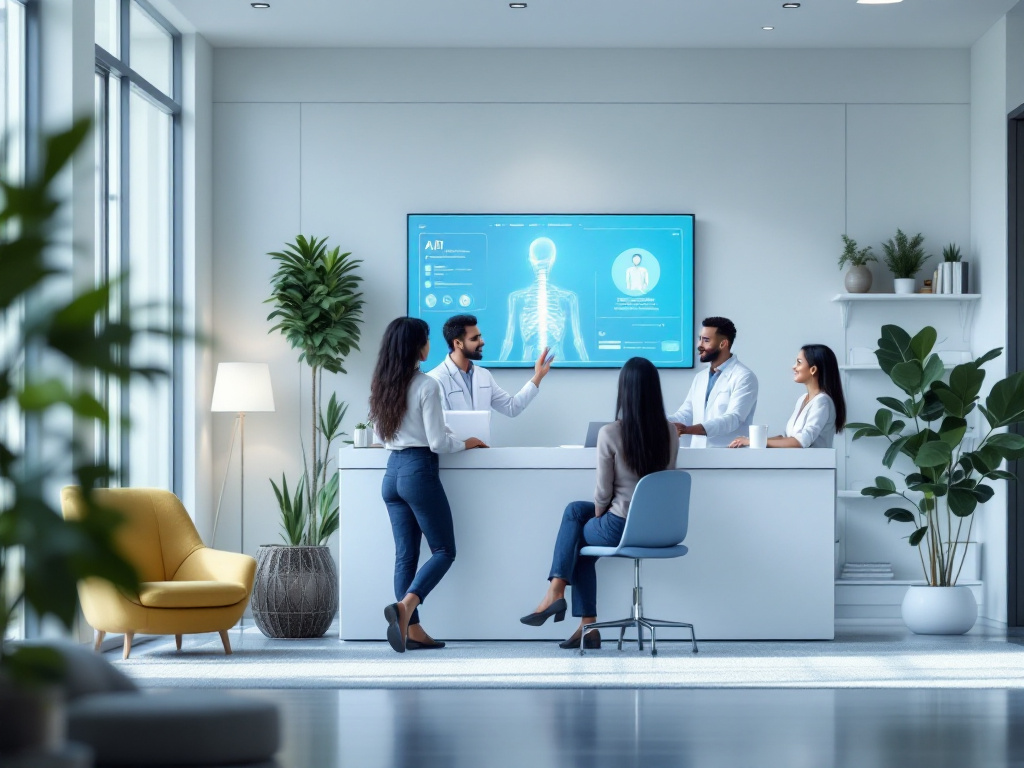Recognize Why Back Pain Patient Experience Matters
Improving your back pain patient experience can transform every stage of care, from the moment a new patient calls your chiropractic office to the follow-up appointments after treatment. When you streamline interactions and coordinate spinal health care more effectively, you nurture patient confidence in your expertise and show genuine commitment to their well-being.
This boost in patient trust ultimately fuels your practice’s reputation. People are far more likely to recommend a chiropractor who demonstrates compassion, professionalism, and efficiency than one who leaves them waiting in noisy reception areas. By focusing on automation, you not only speed up tasks but also create a supportive and personalized environment for existing and prospective patients.
Optimize Communications With an AI Receptionist
At the core of successful chiropractic practices, you often find a reliable front desk team. However, juggling phone calls, online inquiries, insurance verifications, and appointment reminders can be overwhelming for even the best staff. An AI receptionist reduces that burden by automating many of these tasks, freeing up your team to focus on higher-level patient interactions.
Provide 24/7 Patient Support
Your patients do not only seek help during normal working hours. Many back pain sufferers need quick answers about available appointment times or want to schedule an urgent visit before discomfort worsens. An AI receptionist for chiro practices can answer routine questions any time of day, so your patients get instant support. This eliminates the frustration of waiting for office hours to resume and helps you capture leads that might otherwise slip away when your doors are closed.
Personalize Interactions
Automation does not have to be impersonal. Modern AI solutions can ask basic questions about a patient’s discomfort levels, desired appointment time, or specific concerns related to back pain, then record these details for your staff to review. This personalized approach ensures that when a patient walks into your practice, you have immediate awareness of their condition and can jump right into a tailored conversation about how you plan to help them.
Simplify Insurance and Documentation
Patients often dread the tangle of insurance forms. An AI-powered system can streamline data collection and secure preliminary documentation online before the patient even arrives. With chiro insurance verification ai, you reduce time wasted scrambling for coverage details, boosting your back pain patient experience by letting you focus on care delivery from the start.
Improve Scheduling for Seamless Care
Long wait times and endless back-and-forth phone calls can deepen patient anxiety, especially when chronic back pain is involved. By leveraging chiro practice automated scheduling technology, you shorten queues and give people convenient ways to book, modify, or cancel appointments without ever picking up the phone.
Reduce No-Shows and Wait Times
Missed appointments can disrupt your schedule and delay essential care. Automated tools let you send gentle reminders, giving patients time to confirm or reschedule. Tools like spinal treatment reminders can keep patients on track, ensuring they do not miss appointments and have minimal wait times once they arrive. This level of efficiency shows a clear commitment to their comfort and spinal health.
Adjust in Real Time
When a patient cancels last minute, you need to fill that slot to prevent uneven scheduling. AI-driven cancelation management can immediately alert you to open time slots, and you can offer them to stand-by patients or urgent cases. Features like chiro waitlist automation automatically notify prospective patients that an earlier appointment is available. This real-time reshuffling gives your practice a professional edge.
Personalize Treatment Coordination
People experiencing chronic back pain appreciate feeling seen and heard. Providing a supportive environment means recognizing that every patient’s situation is unique. Automating the data collection and coordination process allows you to customize treatment plans without adding administrative stress to your staff.
Tailor Treatment Plans
When you receive detailed patient data upon intake, it becomes much easier to personalize each treatment path. Automated systems for patient spinal assessment automation can gather posture details, discomfort descriptions, and health history before the first appointment. You then walk into your consultation with the information needed to propose targeted adjustments, soft-tissue work, or recommended exercises. Patients perceive this efficiency as genuine attentiveness to their concerns.
Strengthen Follow-Up Care
Your care does not end once a patient leaves the office. Consistent follow-up reminders help ensure that patients attend additional therapy or check-ins, making your recommendations more effective. You can set up chiro follow up automation to communicate upcoming appointment details or prompt patients to complete short progress surveys. By monitoring their recovery journey, you show you are invested in their long-term comfort, not just a quick fix.
Enhance Patient Education and Engagement
In many cases, patient anxiety stems from a lack of knowledge. People battling back pain wonder how long recovery takes, what exercises they should try at home, and whether they will need ongoing care. Automated systems can help bridge those gaps by delivering targeted educational resources that empower patients to take control of their well-being.
Provide Helpful Resources
Sending relevant articles or short videos that address a patient’s specific concerns helps them feel better prepared for their chiropractic journey. With chiro patient education coordination, you can guide patients toward recommended stretches, posture tips, and lifestyle changes that support spinal health. When they understand the purpose and timeline of their care plan, your patients are more likely to trust the process and stick with it.
Foster Collaboration Beyond the Office
You can also encourage dialogue by creating digital feedback loops. Automated email or text prompts might invite patients to share updates on how an exercise feels or whether their pain level has decreased since the last adjustment. Such updates can be quickly reviewed by your staff, giving you an ongoing pulse on how well treatment is working. This level of virtual collaboration stands out, because it shifts the patient’s perspective from simply attending appointments to actively partnering in their spinal health journey.
Boost Practice Efficiency and Growth
As you refine your scheduling, patient communication, and follow-up protocols through automation, you can accomplish more in a shorter time. Efficiency impacts your bottom line, letting you see more patients without sacrificing quality. With a robust system, your practice can maintain consistent revenue flow and stabilize staff workloads.
Free Up Staff Time
When you let automation handle routine calls or appointment setting, your team can concentrate on patient needs that require a human touch, such as in-depth patient consultations or addressing complex cases. By cutting time spent on administrative drudgery, you boost morale and lower the likelihood of burnout among your staff. Tools like chiro front desk automation and chiro office ai assistant go a long way toward streamlining day-to-day responsibilities.
Respond Swiftly to Emergencies
Some back pain flares require short-notice adjustments, and urgent scheduling can drastically improve a patient’s comfort. With the help of chiro emergency appointment system, you can instantly see where someone in sharp pain can be squeezed in for a quick evaluation or possible treatment. Fast and thoughtful responses reassure your patients that you prioritize their comfort whenever unexpected issues arise.
Measure and Refine Your Workflow
Digital tools often include dashboards that track appointment volumes, average wait times, and patient satisfaction metrics. By keeping a close eye on these figures, you can pinpoint bottlenecks in your process. Maybe your practice sees a spike in appointment requests on Monday afternoons, or perhaps patient satisfaction drops for late-day visits. Having actionable data helps you tweak staffing, scheduling, or communication strategies to create the best possible experience.
Increase Patient Satisfaction With Comprehensive Follow-Through
A positive back pain patient experience does not end with a single session. Patients need encouragement, reassurance, and clear next steps. By integrating automated follow-through across every phase of care, you nurture ongoing loyalty and genuine gratitude. Over time, this strengthens your reputation in the community and can spur patient referrals through word of mouth.
Offer Customized Wellness Plans
Many times, your patient needs support beyond a typical adjustment schedule. By collecting data on their posture, daily activity levels, and pain frequency, you can suggest a helpful mix of chiropractic techniques, targeted exercises, or even complementary therapies like massage. Automated tools for chiro treatment plan coordination help you create these individualized plans, so you can easily update protocols whenever a patient progresses or plateaus.
Encourage Open Communication
Encourage patients to reach out if a certain exercise aggravates their condition or if they notice the slightest improvement sooner than expected. This direct feedback loop keeps you informed and helps you adjust their treatment strategy over time. Having a digital system in place that flags a patient’s query can save you from missing important signs of flaring pain. Timely responses show you genuinely care, bolstering patient confidence in your practice.
Implement an Automation Roadmap
Maybe you have already begun adopting partial automation tools, such as online appointment requests or automated reminders. However, to truly optimize the back pain patient experience, you will want to expand your roadmap to include a broader set of advanced features.
Evaluate Your Current Systems
Start by assessing the efficiency of your administrative workflows. Are staff members consistently overwhelmed by front-desk inquiries? Do patients often complain about wait times on the phone? By pinpointing these pain points, you can build an automation plan that tackles your biggest bottlenecks first. Sometimes, integrating a single tool for chiro missed calls solution can radically reduce patient frustration.
Choose the Right Platforms
Select AI solutions that align with your practice’s size and growth goals. A small office might benefit most from a core scheduling platform that manages routine chats and forms. Larger practices or those experiencing a high volume of patients might require robust systems like chiro practice management that bundle automated scheduling, billing, and patient outreach. The ideal choice will integrate seamlessly with your existing software, ensuring no major disruptions to your workflow.
Train Your Team
Even the best automation toolset is only as strong as the people using it. Make sure everyone from your front desk to your chiropractic assistants knows how to navigate these new systems. Provide clear, hands-on demos, and offer resources or quick reference guides to handle frequent tasks. When your staff understands each tool’s purpose, they can confidently guide patients and handle unusual issues that pop up.
Track and Reassess
Your automation journey will evolve over time. You might start with appointment reminders, then realize your practice also needs a solution for better patient feedback collection. Periodically evaluate what is working and where automated processes might need adjusting. Consistent improvement helps you maintain a stellar back pain patient experience, ensuring patients receive the timely care they need while feeling valued at every step.
Encourage a Culture of Continuous Improvement
Integrating automation into your chiropractic practice is not a one-time project. You and your team should remain open to new technology that can further enrich patient interactions and streamline day-to-day duties. A culture of continuous improvement ensures your patients always have the most up-to-date and effective support.
Gather Regular Feedback
Invite patients to share their opinions on your scheduling process, interaction quality, and back pain relief outcomes. Whether through short surveys or automated email check-ins, this information can drive decisions about what to refine next. Hearing success stories also motivates your staff by reminding them how their work impacts lives.
Celebrate Wins Along the Way
When you see a drop in missed appointments or notice more positive patient reviews, take a moment to celebrate. Acknowledge your staff’s efforts and reinforce the importance of working together to deliver an exceptional experience. Recognizing these smaller victories keeps morale high and sets a constructive tone for future changes.
Advance Your Practice With Data-Driven Insights
When you automate administrative tasks, you generate a wealth of data that can reveal deeper insights into patient behavior and practice trends. Leveraging these metrics can help you plan marketing, target community outreach, and refine your approach to patient retention.
- Identify Seasonal Patterns: Track when appointment bookings peak during the year. If you see more patients with back pain in the winter, consider promoting specialized services during that period.
- Refine Communication Channels: If patients respond quickly to text reminders but ignore emails, focus on offering SMS-based appointment confirmations.
- Align With Wellness Programs: By analyzing who consistently books spinal checkups or belongs to your maintenance program, you can promote additional services such as chiro wellness program scheduling to patients who may benefit from preventive care.
As you mine these data insights, you can tailor your practice’s focus to meet real patient needs, from advanced posture assessments to expanded scheduling options for weekend visits.
Make Automation Part of Your Patient-Centric Culture
Ultimately, the goal of automation is not to replace human interaction but to enhance it. If you integrate these tools thoughtfully, you will find your staff has more time for personal conversations, deeper patient education, and individualized treatment planning. When patients feel you are fully invested in their care, they are more likely to follow through on treatment plans, refer friends to your practice, and remain loyal.
Chronic back pain can profoundly affect quality of life. By harnessing AI-powered solutions, you reduce the logistical headaches that come with scheduling, intake, and follow-up, allowing you to focus on delivering high-quality care. As you do, you will notice your patients’ confidence soaring, your practice’s efficiency improving, and your overall reputation growing in the community.
Let automation help you simplify the back pain patient experience, so you and your team can keep shining your expertise on what matters most: improving lives, one adjustment at a time.








Leave a Reply